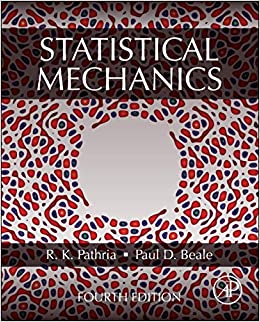The classical Lagrangian for a diatomic molecule with particle masses (m_{1}) and (m_{2}) is [mathcal{L}=frac{1}{2} Mleft(dot{X}^{2}+dot{Y}^{2}+dot{Z}^{2} ight)+frac{1}{2}
Question:
The classical Lagrangian for a diatomic molecule with particle masses \(m_{1}\) and \(m_{2}\) is
\[\mathcal{L}=\frac{1}{2} M\left(\dot{X}^{2}+\dot{Y}^{2}+\dot{Z}^{2}\right)+\frac{1}{2} \mu \dot{r}^{2}+\frac{1}{2} \mu r^{2} \dot{\theta}^{2}+\frac{1}{2} \mu r^{2} \sin ^{2} \theta \dot{\phi}^{2}-\frac{1}{2} k_{s}(r-a)^{2},\]
when written using center of mass and rotational and vibrational coordinates, where \((X, Y, Z)\) is the center of mass position, \(M=m_{1}+m_{2}\) is the total mass, \(\mu=m_{1} m_{2} /\left(m_{1}+m_{2}\right)\) is the reduced mass, \(r\) is the distance between the particles, and \(a\) is the unstretched length of a harmonic spring with spring constant \(k_{s}\). Determine the Hamiltonian from the Lagrangian, and evaluate the one-particle partition function \(Q_{1}(V, T)\) by integrating over the 12-dimensional phase space \(d \Gamma=d X d p_{X} d Y d p_{Y} d Z d p_{Z} d r d p_{r} d \theta d p_{\theta} d \phi d p_{\phi} / h^{6}\). Write the specific heat \(C_{V} / N k\) in terms of the ratios of integrals over \(r\), evaluate the integrals numerically, and plot as a function of \(k T / k_{s} a^{2}\). Explain the limiting low temperature and high temperature limits using the equipartition theorem. Show that the Hamiltonian written using Cartesian coordinates \(H=\frac{\boldsymbol{p}_{1}^{2}}{2 m_{1}}+\frac{\boldsymbol{p}_{2}^{2}}{2 m_{2}}+\frac{1}{2} k_{S}\left(\left|\boldsymbol{r}_{12}\right|-a\right)^{2}\) gives the same partition function.
Step by Step Answer:






